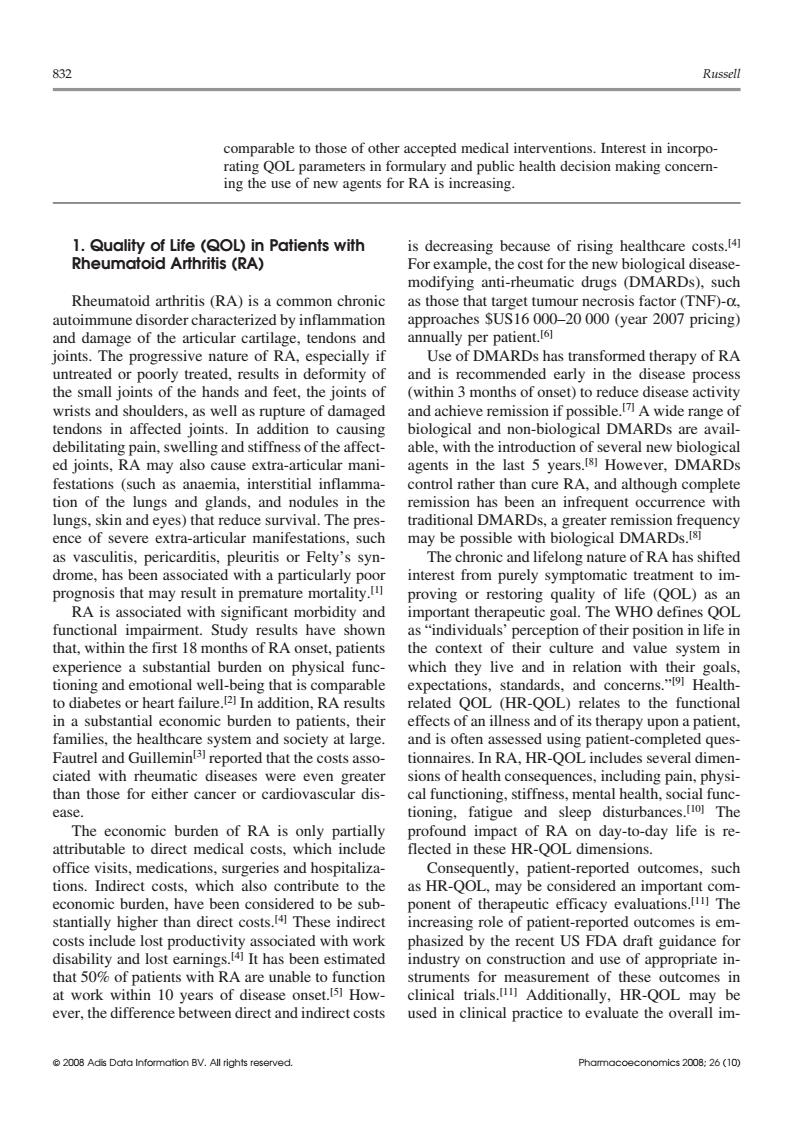正在加载图片...

832 Russell comparable to those of other accepted medical interventions.Interest in incorpo- ew agents reasing 1.Quality of Life (QOL)in Patients with is decreasing because of rising healthcare costs.4 Rheumatoid Arthritis (RA) Rheumatoid arthritis(RA)isa as thos untreated or r orly treated results in deformity of the small joints of the hands and feet,the joints of (within 3 months of onset)to reduce disease activity wrists and shoulders.as well as rupture of damaged and achieve remission if possible.A wide range of tendons in affected joints.In addition to causing biological and non-biological DMARDs are avail- r man last 5 yea Ho an cure nd no in the al Th infrequent o ence of severe extra-articular manifestations.such may be as vasculitis,pericarditis,pleuritis or Felty's syn- The chronic and lifelong nature of ra has shifted me m interest from purely symptomatic treatment to im- oroving or restoring quality of life (QOL)as an RA is associated with significant morbidity and important therapeutic goal.The WHO defines QOL RA nse system in and su they live a lates to the fun effects of an illness and of its therapy up on a patient and is often assessed using patient-completed ques- Fautrel and Guillemin reported that the costs asso- tionnaires.In RA,HR-QOL includes several dimen- ciated with rheumatic diseases were even greater sions of health consequences,including pain,physi than those for either cancer or cardiovascular dis- fatigue The of RA is only part sleep disturbances day-to-day life isre costs,which ir dimer es,such rt economic burden.have been considered to be sub ent of theraneuti c efficacy evaluations.The stantially higher than direct costs.4 These indirect increasing role of patient-reported outcomes is em- phasized by the recent US FDA draft guidance for industry on construction and use of appropriate in- struments f outcomes in at we years of disease on clini ndirect costs used in practice to evaluate the overa832 Russell comparable to those of other accepted medical interventions. Interest in incorporating QOL parameters in formulary and public health decision making concerning the use of new agents for RA is increasing. 1. Quality of Life (QOL) in Patients with is decreasing because of rising healthcare costs.[4] Rheumatoid Arthritis (RA) For example, the cost for the new biological diseasemodifying anti-rheumatic drugs (DMARDs), such Rheumatoid arthritis (RA) is a common chronic as those that target tumour necrosis factor (TNF)-α, autoimmune disorder characterized by inflammation approaches $US16 000–20 000 (year 2007 pricing) annually per patient.[6] and damage of the articular cartilage, tendons and joints. The progressive nature of RA, especially if Use of DMARDs has transformed therapy of RA untreated or poorly treated, results in deformity of and is recommended early in the disease process the small joints of the hands and feet, the joints of (within 3 months of onset) to reduce disease activity wrists and shoulders, as well as rupture of damaged and achieve remission if possible.[7] A wide range of tendons in affected joints. In addition to causing biological and non-biological DMARDs are availdebilitating pain, swelling and stiffness of the affect- able, with the introduction of several new biological ed joints, RA may also cause extra-articular mani- agents in the last 5 years.[8] However, DMARDs festations (such as anaemia, interstitial inflamma- control rather than cure RA, and although complete tion of the lungs and glands, and nodules in the remission has been an infrequent occurrence with lungs, skin and eyes) that reduce survival. The pres- traditional DMARDs, a greater remission frequency ence of severe extra-articular manifestations, such may be possible with biological DMARDs.[8] as vasculitis, pericarditis, pleuritis or Felty’s syn- The chronic and lifelong nature of RA has shifted drome, has been associated with a particularly poor interest from purely symptomatic treatment to imprognosis that may result in premature mortality.[1] proving or restoring quality of life (QOL) as an RA is associated with significant morbidity and important therapeutic goal. The WHO defines QOL functional impairment. Study results have shown as “individuals’ perception of their position in life in that, within the first 18 months of RA onset, patients the context of their culture and value system in experience a substantial burden on physical func- which they live and in relation with their goals, tioning and emotional well-being that is comparable expectations, standards, and concerns.”[9] Healthto diabetes or heart failure.[2] In addition, RA results related QOL (HR-QOL) relates to the functional in a substantial economic burden to patients, their effects of an illness and of its therapy upon a patient, families, the healthcare system and society at large. and is often assessed using patient-completed quesFautrel and Guillemin[3] reported that the costs asso- tionnaires. In RA, HR-QOL includes several dimenciated with rheumatic diseases were even greater sions of health consequences, including pain, physithan those for either cancer or cardiovascular dis- cal functioning, stiffness, mental health, social funcease. tioning, fatigue and sleep disturbances.[10] The The economic burden of RA is only partially profound impact of RA on day-to-day life is reattributable to direct medical costs, which include flected in these HR-QOL dimensions. office visits, medications, surgeries and hospitaliza- Consequently, patient-reported outcomes, such tions. Indirect costs, which also contribute to the as HR-QOL, may be considered an important comeconomic burden, have been considered to be sub- ponent of therapeutic efficacy evaluations.[11] The stantially higher than direct costs.[4] These indirect increasing role of patient-reported outcomes is emcosts include lost productivity associated with work phasized by the recent US FDA draft guidance for disability and lost earnings.[4] It has been estimated industry on construction and use of appropriate inthat 50% of patients with RA are unable to function struments for measurement of these outcomes in at work within 10 years of disease onset.[5] How- clinical trials.[11] Additionally, HR-QOL may be ever, the difference between direct and indirect costs used in clinical practice to evaluate the overall im- © 2008 Adis Data Information BV. All rights reserved. Pharmacoeconomics 2008; 26 (10)